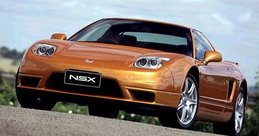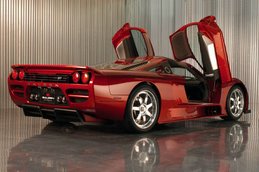 By Bruce McCulloch
By Bruce McCullochWhat is the best American sports car ever made? Is it the Dodge Viper? No, I don’t think so. Is it the Chevrolet Corvette? Arguably it is, but I’m going to have to give ‘Vette fanatics an answer they will most certainly be unsatisfied with - NO! Is it Carol Shelby’s monster, aka the ‘AC Cobra’? Nope, not quite, but you’re getting warmer.
Hint: it’s made by the oldest American motor company in the world. Does that make it obvious enough? The Mustang? I’m afraid not. I’ll give it to you in the brief; it’s the 2005 Ford GT.
In the humble opinion of this automotive enthusiast, the Ford GT stands above all other American sports car attempts as it not only encompasses everything an American sports car should have, but does it in such a manner where many others have failed. Since the beginning of this decade we’ve seen a whole new crop of American sports cars emerge and try to steal the gauntlet, but frankly, very few have succeeded at making any impression whatsoever. What makes that last comment even more ironic is that even Ford themselves have suffered a few mistakes – like the creation of the awful ‘GT90’ concept in the mid ‘90’s.
A brief history: In 2000, with Ford’s centennial year quickly approaching, the design department was asked to create a few concept vehicles which would be presentable at the 2002 North American International Autoshow. That being said, the idea for a recreation of the 1960’s Ferrari-eating “GT40” was not one of those concepts originally expected - in fact, company executives only expected a mocked-up Mustang and a recreation of the Thunderbird for NAIAS. The idea for a “GT40’ concept car came to life on a plane over Sweden, when Wales- born Richard Parry Jones (a long time project director in the Ford Motor company who had worked on such projects as the ’97 Focus, the Escape Hybrid, etc) teamed up with the concept-stylist J. Mays and the Vice President of Advanced Product Creation (APC), Chris Theodore. After a short discussion, the three agreed a ‘GT40’ concept would make the most fitting design for Ford’s upcoming centennial year. Shortly thereafter and with the help of Ford’s Chief of European Operations (Nick Scheele), the wheels were set in motion to make the concept a real car with an aim of slating production for early 2004.
By the time the 2002 North American International Autoshow arrived, stylist J. Mays already had completed a full-sized concept. With introduction, the concept sparked great interest among sports car enthusiasts world wide and whilst the GT40 was only intended as a concept car, Ford soon realized that there was a potential market to produce such a vehicle.
But, uppermost in their mind was the fact that they knew if they were going to create this vehicle, it was going to have to be good. No half-assed operations, no cheapening out – it had to be something which would honestly carry the tradition of the LeMans winning GT40 into the 21st century.
Unfortunately, this was all easier said than done. One of the first and foremost problems which they encountered was retaining the ‘GT40’ name for the production vehicle. While the original rights to this name had long been given up to an English replica manufacturer by the name of ‘Safir Engineering’ and then to a small American firm by the name of ‘Safir GT40 Spares’- the latter allowed Ford to use the GT40 name for concept, but not for the production vehicle. That being said, negotiations between Ford and Safir did in fact take place, but to Safir claims that Ford refused to pay a sum totalling $8 million to purchase the trademark. Nevertheless, such was not going to stop this project and as a result Ford decided to name their new supercar, the ‘GT’.
Further problems ensued, such as making sure the vehicle’s body design was in fact legal for the road, and this further slowed the project. I think most would agree with me in saying that J. Mays GT40 concept offered exactly what an American sports car enthusiast wanted. Unfortunately, while his design was absolutely flawless in terms of paying proper homage to the original vehicle, it featured a few design cues which made it illegal for road use. As a result, the concept vehicle was sent to yet another department where it underwent numerous changes – thankfully none of which undermined the meaning and beauty of the concept.


Concept top, production bottom
The first major rework of this design actually started where most would not have thought, the dimensions. While engineers were able to keep a ride height reminiscent of GT40 Mark II road car (44.3 inches), they were forced to extend the wheelbase by a rather massive 12 inches to accommodate a more spacious interior.
Along with that, road regulations required extensive work to be performed through out the rear-end bumper units and what-not. Not wanting to destroy the design, engineers thought of an intelligent way to implement a bumper unit which not only left the original design unharmed, but also had the advantage of making the entire production process less expensive, and ultimately, easier to assemble. What I speak of is the single attached reinforced steel beam which braces the rear end of the vehicle. Furthermore, the addition of the steel rear bumper meant that for Ford to retain the seamless aerodynamics of both the concept and the original, they made sure the under-body of the vehicle more than made up for it. Such is evident by the fact that the GT featured an under-body covered almost entirely by large sheets of aluminium, not to mention the addition of a front bumper air diffuser and a set of venturi tunnels at the rear. The GT would be not only be able top the sacred 200 mph, but stay planted to the ground when it achieved such a figure.
While most of these changes are noticeable to the naked eye, I cannot bring myself to utter one complaint. The GT invokes every emotion of the original vehicle while retaining a modern feel to the design. It is my humble opinion that J. Mays design work is easily the best retro-recreation of our time.
Fortunately, Ford was faced with fewer issues when it came to redesigning the interior for the production GT. Honestly, with the smallest of changes (most likely not even noticeable to the casual observer) Ford was not only able to retain the GT40-inspired design with it’s ventilated seats and angled gauges, but were able to attach all of the modern necessities (and amenities) required and expected.
That all being said, I think it’s clear that when Ford originally designed the concept, they put a lot of work into it. Such minimal changes to the body, etc cannot be achieved by sloppy design work. That alone, shows a true commitment to this project – even when it was a concept.
Technology, development, drivability, etc:
Frankly, the design alone paved the way for this vehicle, but nevertheless the GT is by no means a low-quality supercar just riding along on the GT40’s heritage. There are no “smoke and mirrors” here…
The interesting thing about the Ford GT is that it’s a supercar which manages to be ‘old school’ without actually being old school. In other words, the GT benefits from various sources of modern day technology, but implements in ways which are only functional – rather than for the purpose of showboating. For instance, the GT’s exterior aluminium body panels are comprised of something which Ford referrers to as ‘super plastic forming’ (or ‘SPF’). This particular operation includes heating the aluminium sheets to 950 degrees Fahrenheit, while forming them to a single-sided die with extremely high air pressure. According to Ford, such an operation not only allows more complicated shapes than what the conventional operation of steel bonding would allow, but is also cheaper and has the added advantage of being lighter. Another weight-decreasing advancement which the GT boasts is an all-aluminium space frame chassis which consists of 35 extrusions, various complex castings and numerous aluminium panels.
While a number of these ideas originated in-house, Ford chose for much of the work to be carried out by a number of outsourcers. Companies including Italian brake supplier Brembo and British transmission assembler Ricardo, gave a great deal of input on the product and obviously, were happy to provide their applicable services to Ford.
So yeah, that’s great and all, but what really defines the GT as the best American sports car ever made is its ability to boast Ferrari-beating performance with usability like no hardcore American sports car before it.
Ford knew if they were going to boast that they had created a “Ferrari killer” they were going to need something fast and make no mistake, the GT is certainly that. Ford knew that whereas Ferrari had been utilizing Formula One technology for their 8-Cylinder engines, similar application would not be appropriate for the historic muscle car. Therefore, Ford reached back into their current vehicle line-up and decided the 5.4 litre V8 found in the Lightning performance pickup truck, would be the best fit. Whilst the concept version boasted 500bhp (certainly more than enough considering the same age Ferrari 360 Modena had 400bhp), it was decided that the production GT would not have 500bhp as press previews had revealed, but rather a sublime 550bhp. Thanks to the addition of a modified exhaust system and a Lysholm supercharging unit the final production version of the engine was putting out a not-too-shabby 550bhp and a rather massive, 500lb-ft of torque peaking at a rather meaty 3,250rpms.

While Ford had originally claimed a zero-to-sixty time of 3.8 seconds and a top speed of over 200 mph – it’s clear that they understated the performance by a tad bit. The final production version reached an unprecedented 212mph at the hands of Ford’s test driver; meanwhile, other various testers often broke the double ton with regularity. Of course, while such a figure was expected and rather common these days, seeing Ford yet again achieve their goal was indeed glorious. The straight line performance of the GT was even more impressive than it’s lavish top end – for instance, British magazine ‘AutoCar’ timed the GT with a zero-to-sixty time of 3.5 seconds and a zero-to-one hundred time of just 7.8 seconds. These figures not only meant the GT was able to annihilate its rivalling competition such as the Ferrari F430 and Lamborghini Gallardo in an ol’ fashion drag race, but hold it’s own against Italian super-exotics like the Lamborghini Murcielago and Pagani Zonda (both of which are considerably more expensive).
That being said, it’s clear that Ford had indeed succeeded in creating a straight line monster, but if other aspects of the vehicle were lacklustre, Ferrari would continue to take the trophy of public opinion.
In all honesty, while the original GT40 was a straight line monster, even its admirers admitted that it was an awful sports car when it came to handling, braking and most everything else. It won races (and man, did it win) by pounding the opposition into the pavement with horsepower and durability. My reason for saying that is not to diminish the original classic, but to rather prove my point about the new-age GT. The same complaint cannot be said for the current GT which manages to consistently tear its European rivals up on various race tracks, no matter what the layout, and while it hasn’t won every race it’s contended in, it’s obvious that the GT boasts very good handling, and consequently, more than a few wins for the trophy shelf.
The best example of this is Sport Auto’s Supertest where the nearly 1600kg GT completed the Nürburgring Nordschliefe in an impressive 7 minutes, 52 seconds. Despite its 50 or so horsepower advantage over rivals, it’s worth mentioning that this robust monster is a great deal heavier than most of its competition. Nevertheless, it is impressive that the GT rips around this famous circuit in a time which not only matches the Lamborghini Gallardo, but out performs the following vehicles: Ferrari F430; Mercedes-Benz CLK DTM; Porsche 997 Turbo, etc. Although this performance glory doesn’t stop at racing circuits, because through out the Supertest the GT remains strong as it out performed both the Ferrari F430 and Lamborghini Gallardo in the 36 metre slalom course, and surprisingly, the wet-handling course. It’s also worth taking note that the GT’s successes have been achieved without many of the technology advantages which its rivals offer - such as: ceramic brakes; traction control; a limited slip differential; Sequential F1-Style Gearboxes, etc.
As I mentioned above, another area where the GT had succeeded all-so fabulously is in its ability to behave itself on the road. People who had imagined the GT would be a stripped-out racer unfit for the road were soon proved wrong. The magazine reviews soon flooded in and they all said the exact same thing – “this a proper recreation of a historic vehicle which not only flaunts good looks and excellent performance, but offers user friendly attributes which we did not think was possible from an American manufacturer”. In 2005, British magazine EVO gave the award of “Car of the Year” to the GT and constantly complimented it for, well, being great.

So there you have it - In my eyes the GT remains the absolute best American sports ever made because it manages to encompass everything a supercar should have. It’s good looking, it’s fast, it handles well and it has great history backed up by the emotional impact expected of any great supercar. Since the release of the GT, Ford has faced a great threat with the Chevrolet and their Corvette Z06 which has already managed (amazingly) to out-perform the GT in most categories. It doesn’t matter though – the GT has a level of allure which the Z06 can only dream of.













3 comments:
He was passionatefor them. Kitty Kat doesnt like the taste of saki, but she knew she could never refuse such an invitation.
true teen sex stories
stories about bestiality
femdom wife enema stories
nifty erotic stories lesbian
spanking erotica art stories
He was passionatefor them. Kitty Kat doesnt like the taste of saki, but she knew she could never refuse such an invitation.
Reaching the bakery store he found himself at sea. ``That was my fear, initially, she said, putting her arms around hiswaist.
young girls masturbation stories
free gay bestiality stories
dog sex bestiality stories
young gay stories
first time dog sex stories
Reaching the bakery store he found himself at sea. ``That was my fear, initially, she said, putting her arms around hiswaist.
Superb poѕt howeνeг I was ωanting
to know іf yоu coulԁ wrіte а lіtte
more on thіs topic? I'd be very grateful if you could elaborate a little bit further. Many thanks!
My blog post; how to get rid of your acne scars
Post a Comment